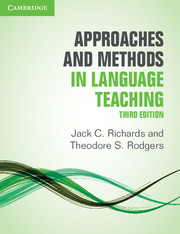Book contents
- Frontmatter
- Contents
- Acknowledgments
- Introduction to the third edition
- I Major trends in twentieth-century language teaching
- II Current approaches and methods
- III Alternative twentieth-century approaches and methods
- IV The teaching and learning environment
- Appendix: Comparison of approaches and methods
- Author index
- Subject index
15 - Total Physical Response
Published online by Cambridge University Press: 08 April 2022
- Frontmatter
- Contents
- Acknowledgments
- Introduction to the third edition
- I Major trends in twentieth-century language teaching
- II Current approaches and methods
- III Alternative twentieth-century approaches and methods
- IV The teaching and learning environment
- Appendix: Comparison of approaches and methods
- Author index
- Subject index
Summary
Introduction
We saw in Chapter 2 that major approaches and methods throughout the twentieth century were generally influenced by theories of language and language learning drawn from the dis-ciplines of linguistics and applied linguistics – and from the 1960s onwards, often from the discipline of second language acquisition. However, some methods were based on learning theories not specific to language learning; for example, Audiolingualism (Chapter 4) drew on behaviorism. Total Physical Response (TPR) is another example of a teaching method that goes outside mainstream applied linguistics for its theoretical basis. It is a language teaching method built around the coordination of speech and action; it attempts to teach language through physical (motor) activity. Developed by James Asher, who was a professor of psychology at San Jose State University, California, it draws on several traditions, includ-ing developmental psychology, learning theory, and humanistic pedagogy, as well as on lan-guage teaching procedures proposed by Harold and Dorothy Palmer in 1925. Let us briefly consider these precedents to TPR.
TPR is linked to the “trace theory” of memory in psychology (e.g., Katona 1940), which holds that the more often or more intensively a memory connection is traced, the stronger the memory association will be and the more likely it will be recalled. Retracing can be done verbally (e.g., by rote repetition) and/or in association with motor activity. Combined tracing activities, such as verbal rehearsal accompanied by motor activity, hence increase the probability of successful recall.
In a development sense, Asher sees successful adult second language learning as a parallel process to child first language acquisition. He claims that speech directed to young children consists primarily of commands which children respond to physically before they begin to produce verbal responses. Asher feels adults should recapitulate the processes by which children acquire their mother tongue.
Asher shares with the school of humanistic psychology a concern for the role of affective (emotional) factors in language learning. A method that is undemanding in terms of linguistic production and that involves gamelike movements reduces learner stress, he believes, and creates a positive mood in the learner, which facilitates learning.
- Type
- Chapter
- Information
- Approaches and Methods in Language Teaching , pp. 277 - 288Publisher: Cambridge University PressPrint publication year: 2014

